Yesterday I had a mini-chess salon at my house, with only two guests: Gjon Feinstein and Mike Splane. Gjon has been to my place many times — so many that he even knows which legs of my chess table are loose! For Mike, on the other hand, it was his first visit.
Mike is the Life Master from San Jose who has lately taken to playing the Birmingham Defense: 1. e4 a6 2. d4 c5, which I discussed in this recent post. His winning streak with this opening has finally been snapped; he showed us a game he lost to Frisco del Rosario that continued 3. dc. It was a very complicated, interesting game, which you can find on his website. It wasn’t really the opening that lost the game, although Mike did lament that his first move out of book was a blunder.
Mike showed us another one of his recent games, which I thought was very interesting as an illustration of what the Russians would call “nichevo-ne-delanye“: not doing anything. Sometimes you don’t have to do anything to win a chess game. If you get in a superior position, you can sometimes just sit on it, make a little threat here and a little threat there, and just let the opponent wear himself out with the onerous task of defending. Eventually the opponent will crack and make a mistake (or two or three …) and then you win.
I am not very good at this “nichevo-ne-delanye” style of playing chess — I am always too impatient to make things happen, and also I often get into time trouble, which makes it even harder to be patient. For that reason, it was very interesting to me to see how Mike does it.
The game was played against an expert by the name of Alex Levitan:
Alex Levitan — Mike Splane
Benoni Defense
1. d4 Nf6 2. c4 c5 3. e3 e6 4. Nc3 d5 5. Nf3 Nc6
Already an interesting position, both from the viewpoint of chess and psychology. I would tend to avoid this position, both as White and as Black, because it is symmetric and therefore appears drawish. But in fact, it’s a very important position! Both sides have played solid, principled moves, and so the position is a litmus test of whether White can get an advantage just by virtue of moving first.
In the game, Levitan played 6. Be2 and seemed to get an inferior or at least no better position after Mike’s 6. … a6! But of course, anything that Black can do, White ought to be able to do better. Therefore it makes sense that White’s best move in the above position must be 6. a3! And, in fact, this is by far the most popular move in ChessBase, having been played more than 3000 times while the next most popular move (6. cd) has been played less than half as often.
Of course, popularity isn’t necessarily proof that a move is good. Why is 6. a3 the best move? Because it forces Black to make a decision. Should he try to maintain symmetry, or try to stick White with an isolated pawn? If you choose “symmetry,” then you play 6. … a6. The trouble is that White replies 7. dc! and you can no longer play symmetrically any more. And if 7. … Bxc5 8. b4 Ba7 9. Bb2 White has gained some territory on the queenside and managed to develop his queen bishop more effectively than Black’s.
On the other hand, if you choose “isolated pawn,” then you reply to 6. a3 with 6. … cd 7. ed dc 8. Bxc4 Be7 9. O-O O-O etc. This variation has been played many, many times, and White has a score well over 60 percent. It is difficult for Black to restrain the pawn break d5 forever, unless he plays … Nd5 blockading the pawn, but that move leaves his kingside somewhat weak. This would be a good position to study if you want to learn about isolated queen’s pawn positions.
Anyway, the actual continuation in the game was 6. Be2 a6 7. a4 (White prevents Black’s queenside expansion, but at the cost of loosening his queenside pawns) 7. … dc 8. Bxc4 Qc7.
Amazingly, 8. … Qc7 is both (a) rare and (b) very successful! According to ChessBase this position has been reached 11 times, with 7 Black wins, 4 draws, and zero wins for White! That’s really remarkable for a position that still looks fairly symmetric and harmless for White.
Okay, let me fast forward a bit to the position where the “nichevo-ne-delanye” starts.
White has just traded queens with 25. Qxg5 hg, and it is now White’s move. Mike says that he actually thought of offering a draw after 25. … hg but decided not to. Black probably has a slight advantage here. Even though White is a tempo ahead in development, with his rook controlling the open d-file, White’s other pieces are pretty poorly placed, playing only defensive roles. In particular there is a danger that he will end up with a bad bishop. But pushing his pawn to e5 (to remove it from the white square) is dangerous because it will be hard to defend the pawn. (On the other hand, there is nothing wrong with pushing the other pawn to a5, and I think White should have done it at some point.)
On the Black side, there are lots of pleasant features in the position. He has the prospect of putting his rook on the h-file, and he also has a bunch of good squares for his knight, such as c5, e5, and f4. The last two outposts, in particular, make good use of the most unusual feature of the position, the pawn on g5. Some beginners or intermediate players might think of this pawn as a weakness because it’s doubled, but in fact it is an asset — it is easily defended and does good work.
In short, what Mike realized is that this is the sort of position that tends to get better all by itself, as the opponent thrashes around and tries to swat away all the annoying little threats that buzz around him.
The game continued 26. f3 Kf8 27. Kf2 Ke7 28. Ne2 Rc8 29. Bb3 Nd7 30. Rc1 Ne5 31. Ke3 …
It will be very educational to compare this diagram to the next one.
31. … Ng6 32. Rc5 Kf6 33. g3? …
Oh-oh. Bad idea. White is understandably tired of worrying about the knight hopping into f4, but by preventing this he creates even worse problems. The pawn on h3 is now very weak, and we have the proverbial “two weaknesses” — a4 and h3 — that give Black real prospects of winning the game.
33. … Rh8 34. Ng1 Ne5 35. Rc2 Rd8 36. Rc3 Ke7
Comparing this diagram with the previous one, we see that in six moves Mike has not done anything. He has moved his pieces back to exactly the same positions they were on move 30! But meanwhile, White’s position has gotten dramatically worse, with the weak pawn on h3 and the knight buried on g1. Amazing!
I’ll just go very quickly over the rest of the game. After seven more moves, Mike has gotten his opponent to put all of his pawns on white squares:
Position after 43. g4.
So now White really and truly has a bad bishop. If you compare this position to the one after move 25, you can see that White has made four pawn moves: b2-b3, f2-f3, and g2-g3-g4, and they have all made his position worse. Mike has made only one pawn move, … e6-e5, and it made his position better (by giving his bishop more scope). Another triumph for doing nothing (or at least, doing very little)!
Finally, eleven moves later, White falls into a nice little trap:
White has just played 54. Be8, probably thinking, “Finally! Some air for my bishop!” But Black has a move that wins tactically. Can you see it?
If you need a hint, Black of course does not want to take time out to defend the f-pawn with 54. … f6 or 54. … Ke7. Look for a more aggressive move that also makes it possible for Black to defend the f-pawn from an unexpected direction.
The answer is 54. … e4!, when White can’t play 55. fe because of 55. … Nxe4+, forking the king and rook. Meanwhile, White has to defend the threat of 55. … e3+, forking the king and rook in an even groovier way. So Levitan played 55. Re2, but after 55. … Rxf3+ 56. Kg2 Kxd5 Mike was two pawns ahead and was simply winning. (His opponent resigned about 15 moves later.)
It’s easy to say with hindsight that White shouldn’t have fallen into this trap, but when a player has been defending for 30 moves, with his position gradually getting worse and worse, this kind of tactical trick becomes almost inevitable.
To me, this kind of win (more than flashy attacks) is what separates the masters from the experts, and the senior masters from the just-barely-masters (i.e., people like me). Good work, Mike! Thanks for sharing this game with us!
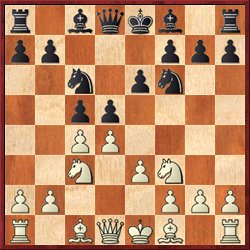
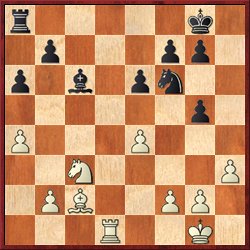
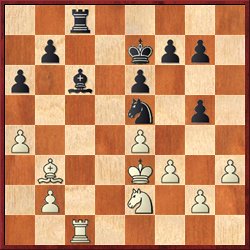
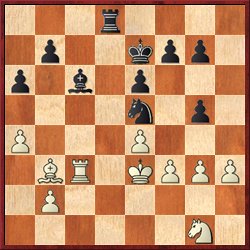
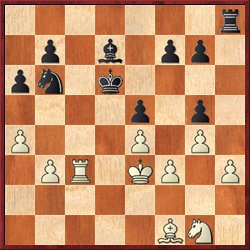
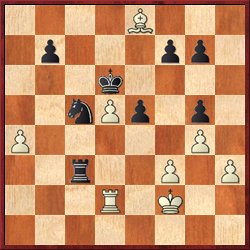



{ 1 comment… read it below or add one }
I always enjoy watching Mike’s games at Kolty chess club, now that they are back in Campbel.